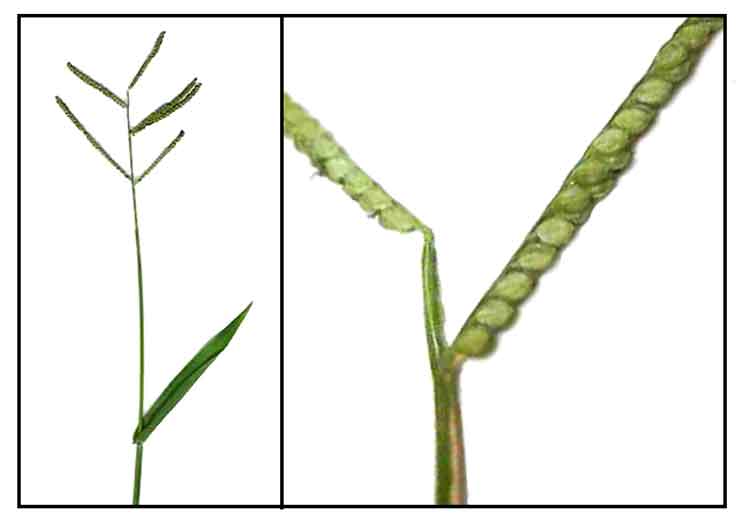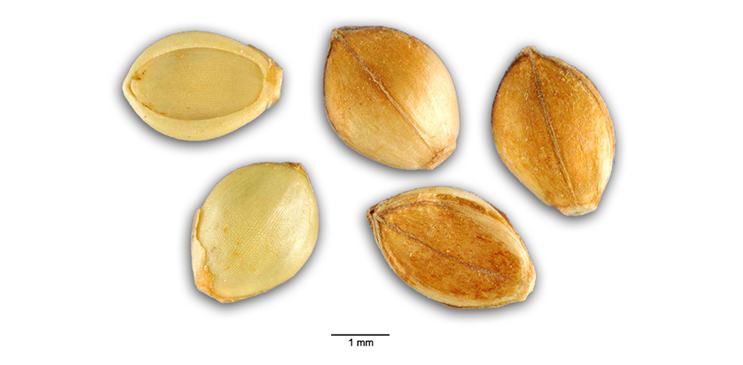
Botany
Bias-biasan is a perennial, tufted, erect, rather slender, nearly glabrous, somewhat wiry plant, 40 to 80 centimeters high. Leaves are flat, 6 to 15 centimeters long and 5 to 8 centimeters wide. Spikes numbers 3 or 4, usually spreading, 4 to 8 centimeters long. Spikelets are pale, 2-seriate, and about 2 millimeters long.
 Distribution Distribution
- Mostly in open grasslands at low and medium altitudes, ascending to 1,500 meters throughout the Philippines.
- Pantropic.
Constituents
- Studies on the proteins of five varieties of kodo millet showed hardly any varietal differences. Study showed gluteln to be the major storage protein. Lysine is the most limiting amino acid followed by methionine and cystine. (8)
- Phytochemical screening yielded tannins, phenolics, saponins, proteins, and carbohydrates.
(10)
- Study showed the millet to contain 1.120 mg/g. phenolics consisting of a flavonol, quercetin, and phenolic acids such as cis- ferulic acid, vanillic acid, syringic acid, p-hydroxy benzoic acid and melilotic acid. Total antioxidant potential was found to be IC50 31.5 ± 0.03 mg/ml in terms of ascorbic acid and gallotannins. The oil consisted of oleic acid (40.7%), stearic acid (37.5%) and palmitic acid (19.5%). (11)
- Various crude extracts of millet grains were evaluated for total phenolic content and total flavonoid content. Total phenolic content with gallic acid as standard of 765 nm ranged from 40.15 ± 17 to 175.94 ± 1.018 µg/moo µg extract. Total flavonoid content with 510 nm as rutin ranged from 4.88 ± 0.50 to 116.48 ± 1.57 µg/100 µ extract. The ethanol extract showed maximum phenolic content and highest flavonoid content. (14)
Properties
- Studies have suggested antidiabetic, antihyperlipidemic, tranquilizing, wound healing, anti-proliferative properties.
Parts used
Stem juice, rhizomes, roots.
Uses
Edibility
- A staple food in some parts of Africa and North India.
- Seeds reported eaten cooked; used as rice, boiled or parched and ground into flour.
(13)
Folkloric
- Juice expressed from the stem used` for corneal opacities.
- Decoction of roots and rhizomes used as alterative in childbirth.
- In India, in cases of poisoning, eating of the grains of the grass is prescribed.
- Grains used in the treatment of diabetes.
- In Pauri Garhwal Uttrakhand, roots used for treatment of painful urination and eye diseases. (22)
Studies
• Antidiabetic:
Study of aqueous and ethanol extracts in rats with alloxan-induced diabetes showed a dose-dependent fall in fasting blood glucose. Treatment also showed a significant increase in liver glycogen and a significant decrease in glycated haemoglobin levels. (1)
• Chronic Toxicity Study / Grain Husk:
Study of dried ethanol extract of the husk of the grain of Paspalum scrobiculatum produced (1) tranquilization and tremors in various animal species (2) potentiated the effect of hexobarbitone in mice (3) produced hypothermia in mice and rats (4) enhanced leptazol toxicity in rats (5) hypotension and diminished carotid occlusion reflex in anesthetized dogs. (3)
• Tranquilizing Effect:
Previous acute and subacute toxicity study in animals showed a considerable margin of safety. In this study, a dried ethanol extract of husk of Paspalum scrobiculatum grain was given to forty psychotic patients in a double blind control, cross over method. The extract was found to have a tranquilizing effect on patients. (7)
• Wound Healing:
Study in animals showed a paste from P. scrobiculatum hastened wound healing. Significant increases in protein and collagen occurred with more rapid wound closure at the wound area where the poultice was applied. (•) Study evaluated the influence of finger miller and kodo millet on rat dermal wound healing on an excision wound model. There was a significant increase in protein and collagen contents and decrease in lipid peroxides, with lower number of days for complete wound closure. (15)
• Free Radical Quenching Potential:
Six different millets were screened for free radical scavenging of DPPH. Methanol extracts of the kodo millet flour showed 70% DOOH quenching compared to the other millet extracts that showed 15-33%. (9)
• Antidiabetic Principles: The medicinal properties of the grain can be attributed to quercetin and most of the phenolic acids. Quercetin, the flavonol present in the millet, is known to possess antidiabetic action. In vitro studies showed quercetin can reduce intestinal glucose absorption; block tyrosine kinase to potentiate both glucose and glibenclamide induced insulin secretion, and protect ß cell from oxidative damage induced by H2O2; partially prevent degeneration of ß-cells. Vanillic acid can help prevent the development of diabetic neuropathy by blocking the methylgloxal-mediated intracellular glycation system. (11)
• Inhibition of Human Cervical Cancer Cell Proliferation / Polyphenol Rich Extract: Study evaluated the polyphenol-rich extract of kodo millet (KM) for ability to inhibit growth of human cervical cancer line (HeLa). Decrease in cell proliferation correlated with increasing concentration. Growth inhibition was accompanied by membrane blebbing, appearance of apoptotic bodies, loss of mitrochondrial potential increase production of ROS and DNA damage, Phytochemical screening revealed phenolic acids like quercetin and cinnamic acid. Study suggests PEKM has ability to inhibit cell growth in a dose-dependent manner and can stimulate apoptosis in cancer cells. (13)
• Antidiabetic Principles / Phospholipids and Fixed Oil: Study suggests the antidiabetic and hypolipidemic activities may be attributed to quercetin and most of the phenolic acids such as cis-ferulic acid, vanillic acid, syringic acid, p-hydroxy benzoic acid and melliotic acid. Oil yields oleic acid (40.7%), stearic acid (37.5%), and palmitic acid (19.5%). Phospholipid yield in the grain was 0.24%.Along with phopholipids, fiber contents, and low oil content, the grain earns a true "Nutraceutical" rating. (16)
• Cyclopiazonic Acid / "Kodua Poisoning" / Seed: Cyclopiazonic acid was isolated from a sample of kodo millet seed that was considered a cause of "kodua" poisoning in man. The extract of the toxic grain produced symptoms of depression and complete loss of immobility when injected intraperitoneally into mice. The seed was infected by Aspergillus flavus and A. tamarii and both fungi produced cyclopiazonic acid. Study was the first report on the association of mycotoxin with kodua poisoning and A. tamarii with mycotoxicosis. (17)
• Antihyperlipidemic: Study of evaluated a hydroalcoholic extract of P. scrobiculatum grains for antihyperlipidemic activity in high fat diet-induced hyperlipidemic albino rats. Results showed significant decrease in body weights, TG, TC, LDL, VLDL, and a significant increase in HDL. (18)
• Inhibition of Collagen Glycation: Study of methanolic extracts of Finger millet (Eleusine coracana) and Kodo millet (Paspalum scrobiculatum) implicated the potential usefulness of both millets in protection against glycation and cross-linking of collagen. (19)
• Antimalarial: Study evaluated the antiplasmodial activities and toxicity of some medicinal plants used to treat malaria and malaria-like symptoms in Ghana against three strains of Plasmodium falcifarum: FCM, W2, and CAM06 in vivo via a 4-day suppression test in Plasmodium berghei infected mice. Paspalum scrobiculatum and Faurea speciosa showed promising to moderate antiplasmodial activities against all 3 strains i.e., Paspalum scrobiculatum was most active towards W2. IC 50 against all strains were well below 10 µg/mL. On cytotoxicity evaluation, P. scrobiculatum and Bidens pilosa showed good activity against chloroquine-resistant W2 strain. (20)
• Antidiabetic / α-Amylase and α-Glucosidase Inhibitory Activity / Grains: Study evaluated the invitro antidiabetic activity of aqueous and methanolic extracts of F. elephantum fruit and Paspalum scrobiculatum grains using α-amylase and α-glucosidase enzyme inhibition assays. Findings of the invitro antidiabetic assays clearly indicate that F. elephantum fruit and Paspalum scrobiculatum grains possess considerable inhibitory activity against α-amylase and α-glucosidase enzymes, and can be of potential use in diabetic patients. (21)
• Antidiabetic / Antidyslipidemic / Grains: Study evaluated the antidiabetic and antidyslipidemic effects of ethyl acetate and methanol fractions of P. scrobiculatum grains in high fat diet and STZ-induced diabetic rats. Results showed significant reduction of plasma glucose levels, HbA1c, increased plasma insulin levels, and normalized lipid profile and liver function parameters, along with normalization of histopathological changes in the liver, kidney, and pancreas of the diabetic rats, comparable to glibenclamide-treated rats. (22)
• n-Alkanes and /α-Palmitin / Seeds: Study of hexane and methan9l extracts yielded several known fatty acids ster9ols and unusual straight chain hydrocarbons (known for insect pheromone activity) and antitumor glyceride, α-palmitin. (23)
• Acute Hepatotoxicity / Kodo Poisoning due to Cyclopiazonic Acid: Consumption of Kodo millet can cause cute intoxication and poisoning. The grains are frequently infested with Aspergillus tamarii Kita, which produce substantial amount of mycotoxin, cyclopiazonic acid (CPA). CPA can cause hepatotoxic/preneoplastic changes in rat liver. Study showed marked increase in activity of glutamate pyruvate transaminase (GTP) and glutamate oxaloacetate transaminase (GOT) following CPA exposure suggesting acute hepatotoxicity. There was also significant increase in gamma glutamyl transpeptidase (GGT) activity indicating preneoplastic changes in the liver. Study suggest consumption of contaminated Kodo millet is a health hazard due to the CPA produced by A. tamarii associated with the millet. (24)
Toxicity
• Paspalum scrobiculatum is a millet that thrives in the poorest soil. The husk and leaves acquire a poisonous quality attributed to heavy rainfalls. Grain detoxification is achieved by a year of storage or by keeping it overnight in buffalo dung. After detoxification, it is dehusked, boiled and consumed after discarding the supernatant water.
• Accidental ingestion of the toxic grain causes CNS effects within a few hours: sleepiness, tremors and dizziness. Vomiting and abdominal colic may occur.
• In cattle, tremors, convulsions, coma and death may occur. (Britt. J. Pharmacol. (1962), 18, 7-18.)
Availability
Wild-crafted.
|

![]()




 Distribution
Distribution